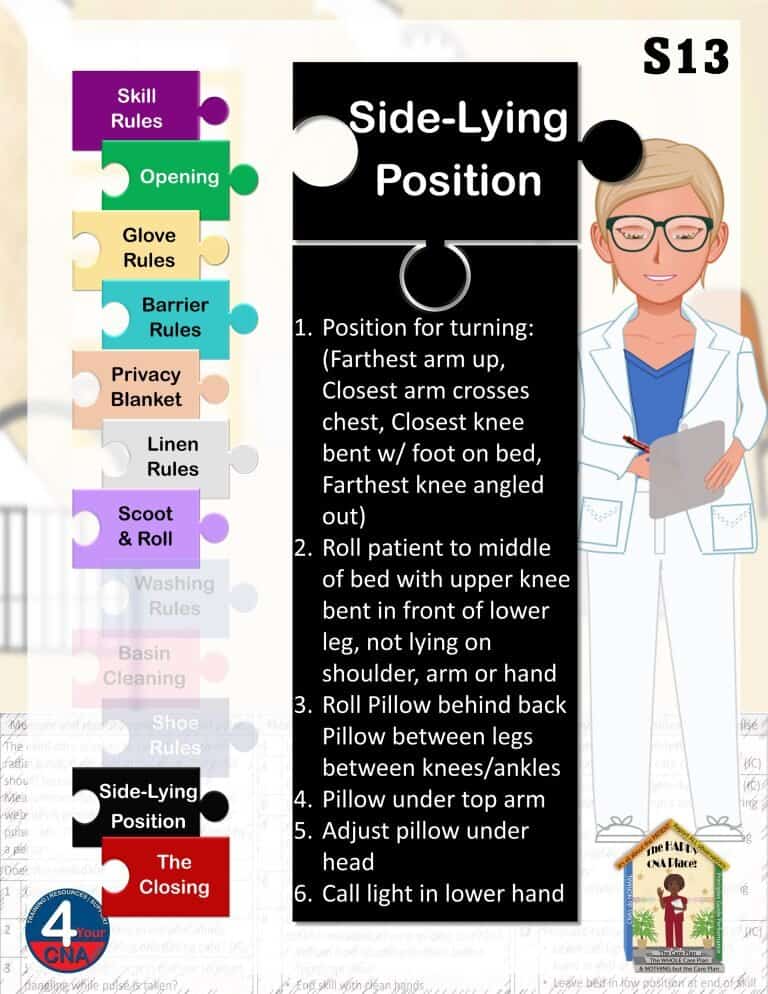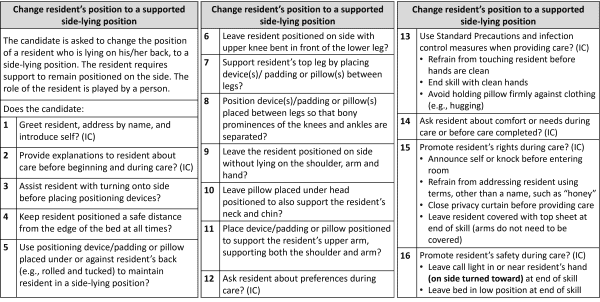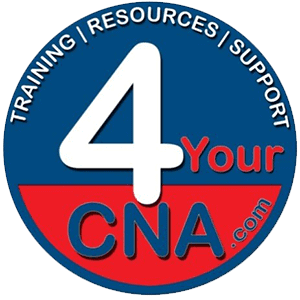Change Position to Supported Side-Lying Position
Repositioning a resident into a supported side-lying position is an essential component of quality care in any healthcare setting. For residents who are bedridden or have limited mobility, regular turning helps prevent serious complications such as pressure injuries, skin breakdown, and respiratory issues. Proper positioning also promotes comfort, improves circulation, and supports proper body alignment. Using pillows or other supports to maintain the side-lying position not only ensures safety but also preserves the resident’s dignity by minimizing discomfort and reducing the risk of falls or injury. This skill reflects a caregiver’s attentiveness to both physical health and emotional well-being—key pillars of person-centered care.
You will need the following to Changing Position to Supported Side-Lying Position:
- Barrier
- 3 Pillows
- Privacy Blanket
1. Preparation & Hand Hygiene
- Read and follow the Care Plan, the whole Care Plan, and nothing but the Care Plan.
- Knock and announce yourself before entering.
- Greet the Resident by name and introduce yourself.
- Explain the task to the Resident and ensure their comfort and consent.
- Close the Privacy Curtain
- Wash your hands thoroughly before beginning.
- Place a Barrier on the Bedside Table.
- Gather your supplies.
- Do Not allow Supplies to touch your Uniform.
- Assess Glove Rules (Are Gloves required for this Resident?)
2. Changing to Side-Lying Position
- Retrieve Privacy Blanket
- Unfold Privacy Blanket and cover Resident for Privacy.
- Do Not Snap or Shake the Blanket.
- Once Privacy Blanket is covering Resident, pull bottom sheet down under the Blanket.
- Ensure Resident is covered throughout Sheet removal.
- Do Not remove bottom sheet.
- Ask Resident to Scoot towards you.
- Position the Resident for turning:
- Farthest Arm up
- Closest Arm crosses the Chest
- Closest Knee bent w/ foot flat on bed
- Farthest Knee angled out
- Count with Resident to the Roll and turn them onto their side.
- Ensure Resident is in the center of the bed after the Roll.
- Ensure Resident is covered with the Privacy Blanket throughout Positioning.
- Lay one pillow on the bed angled against their back, and tuck the top corner underneath the Resident.
- Roll the other edge of the pillow up, and underneath the Resident.
- This will form a Roll along the Resident’s back.
- Move to Resident’s other side.
- Lift the Resident’s Top Leg, from below, supporting at the joints.
- Place a Pillow lengthwise in between the Resident’s Legs.
- Ensure it is resting in between the Knees and ankles.
- Ensure all bony prominences are not touching one another.
- Lift Resident’s Upper Arm, from below, supporting at the joints.
- Place a pillow between the Resident’s Upper Arm and Torso.
- Ensure Arm is in a Neutral Position.
- Adjust Resident’s Head pillow, to ensure it is not under the Resident’s Shoulder.
- Ensure Head pillow is only under the Resident’s Head and Neck.
- Reposition Resident’s Arm to a more comfortable position.
- Place Call Light directly in Resident’s bottom Hand.
- Cover Resident with sheet for Privacy and remove Privacy Blanket.
- Roll Privacy Blanket into a ball as you remove it, and place in the Soiled Linens.
- Do not allow sheet corners to “fly around” or touch anything.
- Dispose of Barrier
- Adjust Resident Sheet for Appearance.
3. Address Resident Comfort & Closing
- Ensure Resident is comfortable.
- Ask about Resident needs and preferences.
- Open Privacy curtain and ensure bed is in lowest position.
- Thoroughly wash your hands.
- Record additional relevant observations.
- Thoroughly wash your hands.
- Think about the Steps of your Skill. Make any corrections. Tell the evaluator your Skills is complete.
Avoid these common testing errors when Changing Position to Support Side Lying Position:
- Not reading and following the Care Plan, the whole Care Plan, and nothing but the Care Plan.
- Not greeting Resident or describing Task.
- Not closing Privacy Curtain.
- Not ensuring Resident safety/positioning while performing Scoot & Roll.
- Allowing linens to touch the floor.
- Allowing linens to touch your uniform.
- Shaking or Snapping sheets.
- Touching Resident with dirty hands.
- Not closing Privacy Curtain.
- Not ensuring Resident safety when rolling.
- Not ensuring Resident is positioned in the center of the bed.
- Not ending Skill with clean hands.
- Not providing Resident with Call Light.
- Not ensuring bed is in the lowest position.


Join our FREE Classroom Livestream on Mondays & Wednesdays from 9am – 1pm (ET) on FLCNATraining.com!

